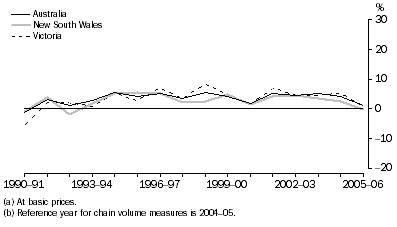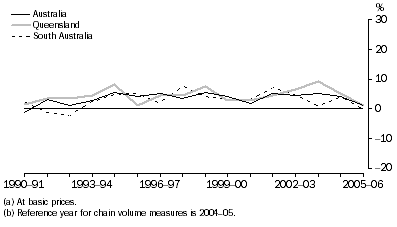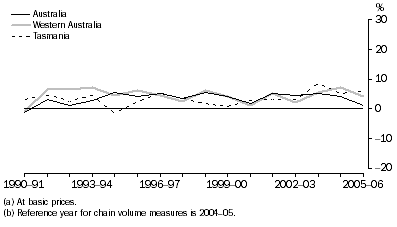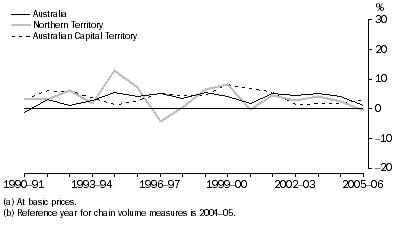RETAIL TRADE
Definition and scope
The Retail trade industry includes all units mainly engaged in the resale (as agents or principals) of new or used goods to final consumers for personal or household consumption or in selected repair activities such as repair of household equipment or motor vehicles.
ANZSIC Division G, Retail trade, consists of three sub-divisions:
- Food retailing (sub-division 51)
- Personal and household good retailing (sub-division 52)
- Motor vehicle retailing and services (sub-division 53).
Summary of GSP(P) sources and methods
The methodology for Retail trade uses an output indicator approach to compile state by industry GVA estimates. Output volumes are derived by deflating total Retail Trade output by state at a division level, except for new car sales which are quantity revalued. The output volumes then form the basis upon which volume measures of value added are derived at the division level.
Current price turnover data is sourced from ABS Retail Trade, Australia (cat. no. 8501.0) and current price Household final consumption expenditure (HFCE) data for consumption outside the scope of Retail Trade, Australia. Price information is sourced from the CPI and used to deflate the current price turnover data to derive a set of turnover volume measures.
For new car sales the quantity indicator is sourced from VFACTS which contains national statistics for sales of new motor vehicles, produced and published on a monthly basis by the Federal Chamber of Automotive Industries.
The volume output measures are weighted together using class level GVA weights to obtain the division GVA volume output measure. The class level GVA weights are derived by multiplying current price turnover data by annual value added to turnover ratios derived from the current price data in the ABS 1998-99 Retail Census and Economy Wide Surveys.
The state output indicators are used to derive volume measures of GVA for Retail trade. The state volume GVAs are benchmarked to the annual national industry volume GVA.
Results for Retail trade
Retail trade gross value added(a), Chain volume measures(b) |
|  |
 | 2000-01 | 2001-02 | 2002-03 | 2003-04 | 2004-05 | 2005-06 |  |
Values ($m) |  |
|  |
| New South Wales | 14 815 | 15 413 | 16 142 | 16 741 | 17 145 | 17 139 |  |
| Victoria | 10 345 | 11 066 | 11 570 | 12 099 | 12 740 | 12 828 |  |
| Queensland | 9 064 | 9 487 | 10 090 | 11 038 | 11 613 | 11 750 |  |
| South Australia | 2 914 | 3 124 | 3 268 | 3 302 | 3 432 | 3 429 |  |
| Western Australia | 4 344 | 4 569 | 4 664 | 4 918 | 5 271 | 5 484 |  |
| Tasmania | 925 | 954 | 983 | 1 067 | 1 123 | 1 191 |  |
| Northern Territory | 433 | 452 | 465 | 484 | 496 | 493 |  |
| Australian Capital Territory | 812 | 857 | 869 | 884 | 901 | 928 |  |
| Australia | 43 646 | 45 921 | 48 048 | 50 525 | 52 720 | 53 242 |  |
Percentage changes from previous year (%) |  |
|  |
| New South Wales | 1.3 | 4.0 | 4.7 | 3.7 | 2.4 | - |  |
| Victoria | 1.4 | 7.0 | 4.6 | 4.6 | 5.3 | 0.7 |  |
| Queensland | 2.7 | 4.7 | 6.4 | 9.4 | 5.2 | 1.2 |  |
| South Australia | 3.0 | 7.2 | 4.6 | 1.1 | 3.9 | -0.1 |  |
| Western Australia | 1.1 | 5.2 | 2.1 | 5.5 | 7.2 | 4.0 |  |
| Tasmania | 2.9 | 3.1 | 3.0 | 8.5 | 5.2 | 6.1 |  |
| Northern Territory | -0.1 | 4.4 | 2.9 | 4.1 | 2.5 | -0.6 |  |
| Australian Capital Territory | 7.0 | 5.5 | 1.4 | 1.8 | 1.8 | 3.0 |  |
| Australia | 1.8 | 5.2 | 4.6 | 5.2 | 4.3 | 1.0 |  |
|  |
| - nil or rounded to zero (including null cells) |
| (a) At basic prices. |
| (b) Reference year for chain volume measures is 2004-05. |
Retail trade gross value added(a), Chain volume measures(b)-Percentage changes

Retail trade gross value added(a), Chain volume measures(b)-Percentage changes

Retail trade gross value added(a), Chain volume measures(b)-Percentage changes

Retail trade gross value added(a), Chain volume measures(b)-Percentage changes

From 2001-02 to 2004-05, all states exhibited positive growth rates of varying degrees with Queensland and Tasmania recording peak growth rates of 9.4% and 8.5% respectively in 2003-04. In 2005-06 there was a significant slow down in growth from the previous year for all states except Tasmania and the Australian Capital Territory, which both increased to 6.1% and 3.0% respectively.
Retail trade gross value added, State shares - Current prices |
|  |
 | 1989-90 | 1994-95 | 1999-00 | 2003-04 | 2004-05 | 2005-06 |  |
 | % | % | % | % | % | % |  |
|  |
| New South Wales | 35.2 | 34.5 | 33.8 | 32.7 | 32.5 | 32.3 |  |
| Victoria | 25.3 | 23.0 | 23.9 | 24.3 | 24.2 | 23.7 |  |
| Queensland | 17.2 | 19.1 | 20.2 | 21.4 | 22.0 | 22.6 |  |
| South Australia | 8.2 | 7.8 | 7.2 | 6.6 | 6.5 | 6.6 |  |
| Western Australia | 8.9 | 10.1 | 10.0 | 10.1 | 10.0 | 10.0 |  |
| Tasmania | 2.4 | 2.6 | 2.2 | 2.2 | 2.1 | 2.2 |  |
| Northern Territory | 1.1 | 1.1 | 1.0 | 0.9 | 0.9 | 1.0 |  |
| Australian Capital Territory | 1.6 | 1.8 | 1.8 | 1.8 | 1.7 | 1.7 |  |
| Australia | 100.0 | 100.0 | 100.0 | 100.0 | 100.0 | 100.0 |  |
|  |
New South Wales, Victoria and Queensland together accounted for 78.6% of Australian Retail trade value added in 2005-06. New South Wales, Victoria and South Australia's shares decreased slightly throughout the time series whereas shares in Tasmania, the Northern Territory and the Australian Capital Territory were quite stable. Western Australia's share increased from 8.9% in 1989-90 to 10.1% in 1994-95 and has stabilised around that level. Queensland gradually increased its share throughout the time series from 17.2% in 1989-90 to 22.6% in 2005-06.
 Print Page
Print Page
 Print All
Print All